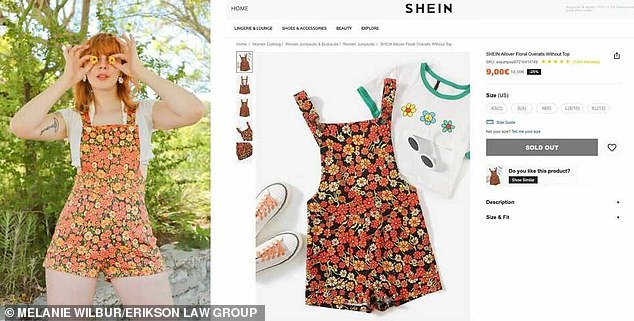Shein, the world’s biggest clothing retailer is facing legal action after being accused of stealing designs. John Hooper uncovers uncomfortable truths on the seamier side of a multibillion-pound industry
In what may be a first for the world of dresses and finery, the world’s largest fashion retailer, Shein, is facing a lawsuit claiming its activities amount to organized crime.
Three American designers – Krista Perry, based in Massachusetts, along with Jay Baron and Larissa Martinez, in California – have brought the case under the US Racketeer Influenced and Corrupt Organizations Act (RICO), which was designed to get gangsters in trouble. They claim that the Chinese fast-fashion giant has continuously ripped off their creations and those of others.
The designers do not claim that Shein is controlled by the Chinese Triads, but they say the company’s business methods – including the alleged theft of thousands of designs and an ever-changing corporate structure – mean it is a ‘coordinated illegal operation’. ‘, comparable to a mafia and subject to the same law.
According to claims made by print designer Perry, she created art that then appeared in identical form on Shein’s website. When she initially complained to Shein about her art being used without permission, she says she was offered $500 (about £400).
“In these cases, Shein quickly apologizes and blames an unnamed third party for the misconduct,” the lawsuit said. The court documents filed this summer also included photos of a floral playsuit designed by Larissa Martinez and a similar one sold by Shein (above right).
The damages sought by the designers were not specified, but their lawyer, David Erikson, told NBC News in the US that their goal was to “rein in (Shein’s) bad behavior and require them to stop copying American designers’.
Warren Beatty and Faye Dunaway as Bonnie and Clyde (with Gene Hackman as Clyde’s brother Buck) in the 1967 film
Shein has said, “We will defend ourselves vigorously,” and the designers’ case has yet to go to trial, let alone be granted. However, in the fashion world, the procedures will be followed carefully as they promise to define what can and cannot be legally copied.
This isn’t the first time Shein has gotten into trouble. In April this year, Yan Tee, a nail artist from Manchester, accused the company of stealing her designs. Shein sold adhesive nails with the same pattern Tee posted on her Instagram from a custom design she created for a client. Shein’s self-adhesive nails start at 75p, while Tee – self-taught, self-employed – charges around £40 for her designs. The company even used Tee’s Instagram images on its website without her permission.
Shein later apologized, saying it “respects designers and artists, and the intellectual property (IP) rights of others.” Where legitimate complaints are made by holders of valid intellectual property rights, Shein will promptly address the situation and remove the products from our site as a precaution while we investigate.”
It did indeed remove the items from the site, but a day later one appeared again. As Tee said at the time: ‘Small artists don’t have the money to take them to court. And I think a lot of that is because copyright laws in China, where they are based, are quite flexible compared to UK copyright laws.”
Fashion and crime are no strangers. The Hollywood version is one of slick gangsters in suits, or Faye Dunaway’s iconic A-line skirt and artfully angled wool beret for her role as bank robber Bonnie Parker in the 1967 classic Bonnie and Clyde.
The reality is of course less attractive. Naples is one of the places where fashion and organized crime overlap in real life. They cross paths in the sweatshops on the slopes of Mount Vesuvius, controlled by the Camorra, the Neapolitan mafia, which produces clothes, including some of the very best gowns, for fashion houses in Milan. And they mingle at the port of Naples, where much of the counterfeit designer clothing made in China ends up in Europe.
In the ranking of illegally traded goods by value, fraudsters are second only to narcotics. In 2007, the Organization for Economic Co-operation and Development (OECD) – the club of rich countries – estimated that the import and export of counterfeit products generated around $250 billion (then around £130 billion) annually.
By far the largest source of counterfeit products was China. Everything is copied without permission, from electronic devices to pharmaceutical products, from fertilizers to aircraft parts.

On the left is Larissa Martinez’s design and on the right is a Shein product
But counterfeit clothing and accessories account for more than half of the world’s trade in counterfeit goods.
The makers and sellers are not all gangsters, but the business they are in fuels organized crime, and some of the profits go to finance both terrorists and gangsters.
The Hollywood version of fashion and crime consists of slick gangsters in suits, like Bonnie and Clyde
For example, officials say the weapons used in the 2015 massacre at French magazine Charlie Hebdo were partly financed by the sale of fake Nike sneakers.
The tentacles of terrorist organizations and criminal syndicates stretch for thousands of kilometers.
And they will almost certainly reach a boutique or market near you.
John Hooper writes about transnational organized crime for The Economist
